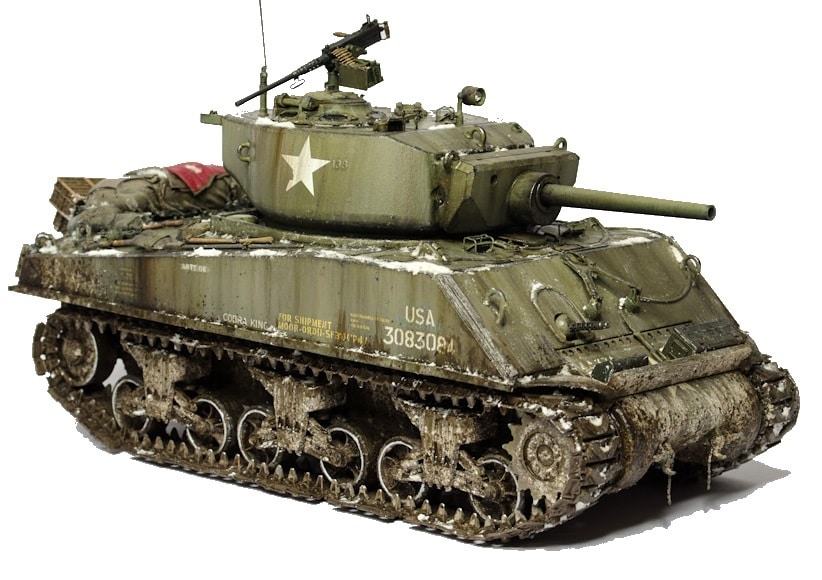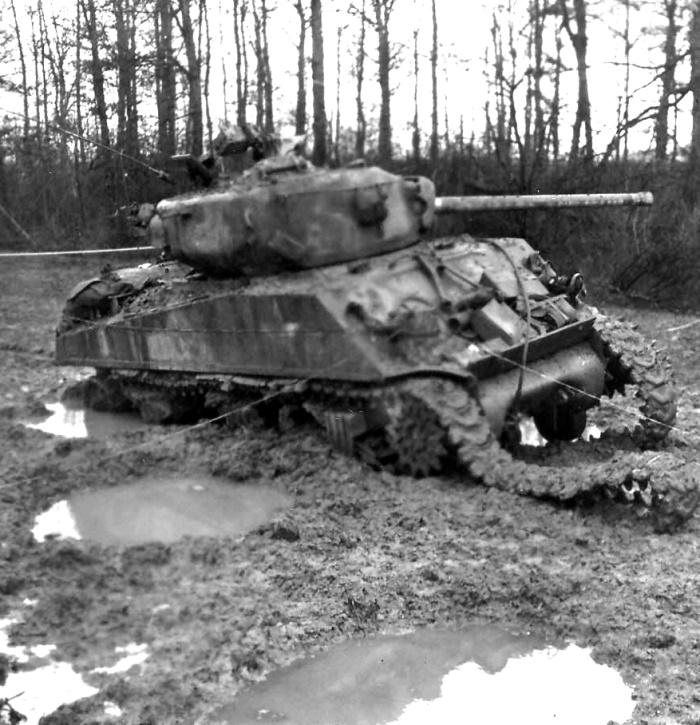To the north, Stavelot had been occupied in force, and on the south Gouvy (a large supply depot) and Cherain were reported to be occupied. It was no longer a question of relieving the surrounded 422 and 423-IRs; it was a question of denying St Vith to the Germans and of keeping the division from being cut off to the rear, if the two combat teams (422 & 423) were to save themselves they would have to fight their way westward to St Vith. Although CCB probably could have denied St Vith to the Germans by holding the high ground to the west of the town, the situation had been such that the defenders had been unable to choose the place for their stand. The enemy had been met in a very critical tactical situation, on the high ground east of the town and he was held from that position until Dec 21. By now, it was known that immediately opposing CCB was a German Corps with the 18.VGD and the 62.VGD, while northeast of CCB in the Recht-Poteau area was at least one combat command from the 1.SS-PD (Kampfgruppe Hansen). Also in the area of the afternoon assault on Baker 38-AIB, 19 dead German paratroopers wearing the insignia of the Gross-Deutschland-Division had been identified. The following was the total of known casualties inflicted on the Germans by CCB-7-AD, after one and one-half days of intense combat: Destroyed, 10 Mark V (Panther); 1 88-MM Assault Gun (Ferdinand); 2 75-MM Assault Guns (StuG III); 8 Armored Cars. Damaged: 2 75-MM Assault Guns (StuG III) and Killed: 339
In the afternoon of Dec 18, it was decided that St Vith was no longer tenable for the Combat Command Hqs, and the latter was moved to Krombach to the southwest. This was accomplished just before dark. Communication and liaison were established with the troops in the line from the new command post and with CCB-9-AD on the right flank. Following a German attack at 2230, which was repulsed, continued noises and troop movements were heard, but no further developments occurred. The experience of Baker 38-AIB, which had been placed in the line east of St Vith, was typical of the small unit action on the nose of the defensive horseshoe. It was the sum total of such actions as these that made up the big picture on Dec 18. An interview with a member of Baker Co reveals a portion of the picture.
At about 0900, Capt Greene came down from the Company CP to check the line, and after checking the 1st Platoon he went on to the 2d. When he was about halfway down to the 2d Platoon, 88-MM fire and small-arms fire announced a German attack by infantry with at least one tank. It was reported that Capt Greene went forward with a Tommy gun. He did not return. Lt Higgins took over command of the company. The main force of the attack was against the 2d and 3d Platoons. At about 1000 or 1100, Lt Jamie1 and Sgt Knight, his platoon sergeant, saw a squad from the 2d Platoon taking off, and the lieutenant sent Sgt Knight after the men. It was the Machine-Gun Squad and they did not return. Their absence weakened the 2d Platoon so that they were forced to fall back about 100 yards. The other two platoons remained in the same positions in foxholes.
The attacking Germans were paratroopers, and they suffered heavy losses. Lt Jamie1 himself saw over 30 dead Germans. The tank which supported them was knocked out by a medium tank of ours. This first attack commenced after 0950 and lasted until about 1500. The remainder of the afternoon and night was quiet. Vehicular movement and even shouted German commands could be heard during the night.
EVENTS OF DECEMBER 18/19
During the night of Dec 18/19, there were noises indicating considerable activity and vehicular movement in the German rear areas. The arrival of more troops to reinforce those already attacking St Vith was expected. After midnight there was constant patrol and counter-patrol activity on both sides and the Germans placed a great deal of harassing fires on all roads and road junctions, using 80 MM and 120 MM mortars, 88’s, and for the first time, artillery firing battalion concentrations. Two-night attacks were launched against CCB’s northern flank with infantry and tanks, apparently in an effort to seize Hünningen. Both attacks were repulsed by the combined fires of the tanks of the 31-TB and of armored cars and assault guns of the 87-CRS. At no time during the day was enemy pressure absent from any portion of the division’s perimeter. At 0930, an attack developed in the area held by Troop C (87-CRS)(Capt D.L. Johnson). At 1355, the 17-TB (Col John P. Wemple) was attached to CCB. At 1510, the 434-AFAB and two batteries of the 965th FAB were attached to CCB and placed in support positions as well as the 275-AFAB.
It seemed that the Germans were seeking a soft spot; if they found one part of the line strongly defended, they pulled back and tried another. Statting on the northern flank at 0539, the enemy attacked in the direction of Hünningen in an attempt to envelop CCB’s left flank. For more than three hours they attacked repeatedly, employing more than 500 infantry supported by tanks. At 1300 they finally withdrew, leaving one tank burning and 150 dead. Other tanks were hit and damaged but were able to withdraw. Another attack started from the direction of Wallerode, where the Germans were massing in strength, but it was broken up when our artillery caught the Germans in the open terrain before our lines. Failing to find a soft spot in the north, the Germans next hit the southern flank where they moved against CCB-9-AD. Before this attack even got going three enemy tanks were knocked out and the rest of the force withdrew to try another place. The southern flank of CCB-7-AD was then hit by a reinforced infantry company with armored support (one Panther and two assault guns).
During the morning, this part of the line had been reinforced by a TD Section of two 90 MM guns from Able 814-TDB. This tank destroyer section, with three rounds, knocked out the Panther and one assault gun, leaving the infantry to advance across open ground with no armored support. Or they came only to be slaughtered by our infantry (Able 23-AIB), who held their fire until the enemy had closed to less than 50 yards. What was left of the attacking Germans quickly fled leaving almost 60 casualties. CCB received additional support at 1510 on Dec 19, when the 434-AFAB and two batteries of the 965-FAB were attached and placed in position.
The only artillery support up to this time had been furnished by the 275-AFAB. The 965-FAB (-), the 275-AFAB, and the 434-FAB were placed under the control of Col James G. Dubuisson, the CO of the 434-FAB; and a group fire direction center, which functioned smoothly and continuously throughout the action, was established. Observation of fires was limited; there were no liaison planes with the artillery at St Vith. Although the enemy was channelized in his movement along the roads, offering wonderful opportunities to destroy him by artillery fire, CCB could not deliver the blow with complete effect because of the lack of aerial observation needed to adjust fire.
During the afternoon of Dec 19, Gen William M. Hoge (CO CCB 9-AD), visited the command post of CCB-7-AD in Krombach. The vulnerability of Gen Hoge’s position on the forward side of the stream and on the railroad, which ran south from St Vith, was discussed. Should St Vith been lost, CCB-9-AD would have been isolated and cut off, as there was no way for them to withdraw their vehicles across the stream and railroad tracks except through St Vith. A plan was agreed upon to be executed after dark that night. First, the vehicles of the 27-AIB (CCB 9-AD), were withdrawn to areas in the rear of the new position. Medium tank companies of the 14-TB followed and the infantry elements came out last. This movement was accomplished without too much difficulty, and the right flank of CCB 7-AD was thereby made more secure. Close liaison and excellent cooperation were maintained between the two combat commands during the whole period in the vicinity of St Vith, even though the next higher headquarters of CCB 9-AD, was in doubt, and conflicting orders were received.
During the morning of Dec 19, part of the 112-IR (28-ID)(Col G. M. Nelson), joined the 7-AD in its defense of this area. The combat team had been out of contact with their division and were completely in the dark as to the location of any friendly troops whatsoever until a patrol from the 7-AD had contacted them. This was an indication of the situation as it existed southwest of CCB.
EVENTS OF DECEMBER 20
St Vith, by the morning of Dec 20, was not yet desperate but was becoming increasingly difficult. Everyone realized by this time that we were not facing a local counter-attack, but a full-scale offensive and that the St Vith defenders were catching a heavy portion of it in their sector. Through intelligence reports from higher headquarters, and captured prisoners, the Americans knew that they were meeting the best of the German troops. CCB-7-AD had a relatively quiet day, but there was a constant build-up of enemy strength for an attack on St Vith. Task Force Jones was formed to secure the southern flank. There was increasing enemy pressure on supply installations at Samrée and La Roche en Ardennes. By the end of the day, prisoners from the following German divisions had been interrogated by the IPW Team of the 7-AD (enemy divisions listed in relative order of positions from north to south): 1.SS-PD, Gross-Deutschland-Brigade, 18.VGD, 62.VGD, 2.PD, 560.VGD and the 116.PD. Manteuffel had assigned the task of taking St Vith to two infantry divisions of the 66.Corps; his failure to accomplish this in a reasonable time had caused the commitment of additional troops from both, the 5.Panzer-Army and the 6.Panzer-Army. All manner of reports were received indicating that the enemy was by-passing the 7-AD’s positions on the north and rolling up the flank on the southeast, making the St Vith sector comparable to a thumb protruding into the enemy’s mouth, and it seemed that this thumb could be easily bitten off. The enemy was reported to be in strength at Houffalize, La Roche en Ardennes, and Samrée, all to the west of CCB, and at Trois-Ponts to the northwest. In order to protect their flank, Division Headquarters, on Dec 19, had ordered the 40-TB and Able 336-AEB, to outpost Cherain and Gouvy.




















